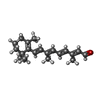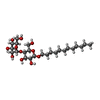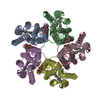+Search query
-Structure paper
| Title | CryoRhodopsins: A comprehensive characterization of a group of microbial rhodopsins from cold environments. |
|---|---|
| Journal, issue, pages | Sci Adv, Vol. 11, Issue 27, Page eadv1015, Year 2025 |
| Publish date | Jul 4, 2025 |
 Authors Authors | Gerrit H U Lamm / Egor Marin / Alexey Alekseev / Anna V Schellbach / Artem Stetsenko / Jose Manuel Haro-Moreno / Gleb Bourenkov / Valentin Borshchevskiy / Marvin Asido / Michael Agthe / Sylvain Engilberge / Samuel L Rose / Nicolas Caramello / Antoine Royant / Thomas R Schneider / Alex Bateman / Thomas Mager / Tobias Moser / Francisco Rodriguez-Valera / Josef Wachtveitl / Albert Guskov / Kirill Kovalev /      |
| PubMed Abstract | Microbial rhodopsins are omnipresent on Earth; however, the vast majority of them remain uncharacterized. Here, we describe a rhodopsin group found in microorganisms from cold environments, such as ...Microbial rhodopsins are omnipresent on Earth; however, the vast majority of them remain uncharacterized. Here, we describe a rhodopsin group found in microorganisms from cold environments, such as glaciers, denoted as CryoRhodopsins (CryoRs). A distinguishing feature of the group is the presence of a buried arginine residue close to the cytoplasmic face. Combining single-particle cryo-electron microscopy and x-ray crystallography with rhodopsin activation by light, we demonstrate that the arginine stabilizes an ultraviolet (UV)-absorbing intermediate of an extremely slow CryoRhodopsin photocycle. Together with extensive spectroscopic characterization, our investigations on CryoR1 and CryoR2 proteins reveal mechanisms of photoswitching in the identified group. Our data suggest that CryoRs are sensors for UV irradiation and are also capable of inward proton translocation modulated by UV light. |
 External links External links |  Sci Adv / Sci Adv /  PubMed:40614199 / PubMed:40614199 /  PubMed Central PubMed Central |
| Methods | EM (single particle) |
| Resolution | 2.3 - 2.94 Å |
| Structure data | EMDB-18795, PDB-8r0k: EMDB-18796, PDB-8r0l: EMDB-18797, PDB-8r0m: EMDB-18798, PDB-8r0n: EMDB-18799, PDB-8r0o: EMDB-18800, PDB-8r0p: |
| Chemicals |  ChemComp-LFA:  ChemComp-RET:  ChemComp-HOH:  ChemComp-LMT: |
| Source |
|
 Keywords Keywords | MEMBRANE PROTEIN / rhodopsin / retinal / cryo-EM / light sensor |
 Movie
Movie Controller
Controller Structure viewers
Structure viewers About Yorodumi Papers
About Yorodumi Papers















 cryobacterium levicorallinum (bacteria)
cryobacterium levicorallinum (bacteria)